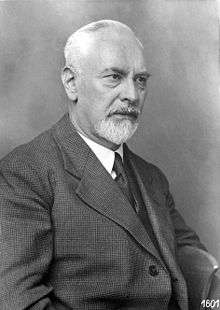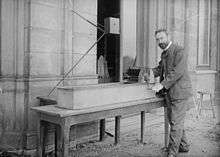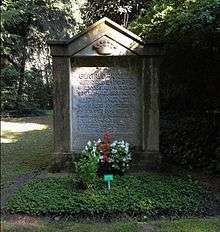Ludwig Prandtl
| Ludwig Prandtl | |
|---|---|
 Ludwig Prandtl | |
| Born |
4 February 1875 Freising, Upper Bavaria, German Empire |
| Died |
15 August 1953 (aged 78) Göttingen, West Germany |
| Nationality | German |
| Alma mater | Technical University of Munich, RWTH-Aachen |
| Known for |
Boundary layer Mixing length theory Prandtl number Prandtl-Batchelor theorem |
| Awards |
Ackermann–Teubner Memorial Award (1918) Daniel Guggenheim Medal (1930) Wilhelm Exner Medal 1951 |
| Scientific career | |
| Fields | Aerodynamics |
| Institutions |
University of Göttingen Technical School in Hannover |
| Thesis | Tilting Phenomena, A case of unstable elastic balance (1899) |
| Doctoral advisor | August Föppl |
| Doctoral students | Ackeret, Blasius, Busemann, Munk, Nikuradse, Pohlhausen, Schlichting, Tietjens, Tollmien, von Kármán, Vishnu Madav Ghatage and many others (85 in total). |
Ludwig Prandtl (4 February 1875 – 15 August 1953)[1] was a German engineer. He was a pioneer in the development of rigorous systematic mathematical analyses which he used for underlying the science of aerodynamics, which have come to form the basis of the applied science of aeronautical engineering. In the 1920s he developed the mathematical basis for the fundamental principles of subsonic aerodynamics in particular; and in general up to and including transonic velocities. His studies identified the boundary layer, thin-airfoils, and lifting-line theories. The Prandtl number was named after him.
Early years
Prandtl was born in Freising, near Munich, in 1875. His mother suffered from a lengthy illness and, as a result, Ludwig spent more time with his father, a professor of engineering. His father also encouraged him to observe nature and think about his observations.
He entered the Technische Hochschule Munich in 1894 and graduated with a Ph.D. under guidance of Professor August Foeppl in six years.[2] His work at Munich had been in solid mechanics, and his first job was as an engineer designing factory equipment. There, he entered the field of fluid mechanics where he had to design a suction device. After carrying out some experiments, he came up with a new device that worked well and used less power than the one it replaced.
Later years
In 1901 Prandtl became a professor of fluid mechanics at the technical school in Hannover, now the Technical University Hannover. It was here that he developed many of his most important theories. In 1904 he delivered a groundbreaking paper, Fluid Flow in Very Little Friction, in which he described the boundary layer and its importance for drag and streamlining. The paper also described flow separation as a result of the boundary layer, clearly explaining the concept of stall for the first time. Several of his students made attempts at closed-form solutions, but failed, and in the end the approximation contained in his original paper remains in widespread use.
The effect of the paper was so great that Prandtl became director of the Institute for Technical Physics at the University of Göttingen later in the year. Over the next decades he developed it into a powerhouse of aerodynamics, leading the world until the end of World War II. In 1925 the university spun off his research arm to create the Kaiser Wilhelm Institute for Flow Research (now the Max Planck Institute for Dynamics and Self-Organization).
Following earlier leads by Frederick Lanchester from 1902–1907, Prandtl worked with Albert Betz and Max Munk on the problem of a useful mathematical tool for examining lift from "real world" wings. The results were published in 1918–1919, known as the Lanchester-Prandtl wing theory. He also made specific additions to study cambered airfoils, like those on World War I aircraft, and published a simplified thin-airfoil theory for these designs. This work led to the realization that on any wing of finite length, wing-tip effects became very important to the overall performance and characterization of the wing. Considerable work was included on the nature of induced drag and wingtip vortices, which had previously been ignored. Prandtl showed that an elliptical spanwise lift distribution the most efficient, giving the minimum induced drag for the given span. These tools enabled aircraft designers to make meaningful theoretical studies of their aircraft before they were built.

Prandtl later extended his theory to describe a bell-like lift distribution, obtained by washing out the wing tips until negative lift was obtained, which gave the minimum induced drag for any given aircraft weight, also suggesting that adverse yaw forces could be countered solely by wing tip aerodynamics, but this new theory was largely ignored. In the 21st century the American engineer Al Bowers has confirmed the idea, calling his experimental wing the PRANDTL-D.[3]
Prandtl and his student Theodor Meyer developed the first theories of supersonic shock waves and flow in 1908. The Prandtl-Meyer expansion fans allowed for the construction of supersonic wind tunnels. He had little time to work on the problem further until the 1920s, when he worked with Adolf Busemann and created a method for designing a supersonic nozzle in 1929. Today, all supersonic wind tunnels and rocket nozzles are designed using the same method. A full development of supersonics would have to wait for the work of Theodore von Kármán, a student of Prandtl at Göttingen.
In 1922 Prandtl, together with Richard von Mises, founded the GAMM (the International Association of Applied Mathematics and Mechanics).[4] and was its chairman from 1922 until 1933. Until 1945 he also worked closely with the RLM.
Other work examined the problem of compressibility at high subsonic speeds, known as the Prandtl-Glauert correction. This became very useful during World War II as aircraft began approaching supersonic speeds for the first time. He also worked on meteorology, plasticity and structural mechanics.
Prandtl and the Third Reich
After Hitler's rise to power and the establishment of the Third Reich, Prandtl continued his role as director of the Kaiser Wilhelm Society. During this period the Nazi air ministry, led by Hermann Göring, often used Prandtl's international reputation as a scientist to promote Germany's scientific agenda. Prandtl appears to have happily served as an ambassador for the Nazi regime, writing in 1937 to a NACA representative "I believe that Fascism in Italy and National Socialism in Germany represent very good beginnings of new thinking and economics." Prandtl's support for the regime is apparent in his letters to G. I. Taylor and his wife in 1938 and 1939. Referring to Nazi Germany's treatment of Jews, Prandtl wrote "The struggle, which Germany unfortunately had to fight against the Jews, was necessary for its self-preservation." Prandtl also claimed that "If there will be war, the guilt to have caused it by political measures is this time unequivocally on the side of England."[5]
Publications
- Paul Peter Ewald, Theodor Pöschl, Ludwig Prandtl; authorized translation by J. Dougall and W.M. Deans The Physics of Solids and Fluids: With Recent Developments Blackie and Son (1930).
- Tietjens, Oskar Karl Gustav; Prandtl, Ludwig (1957). Fundamentals of Hydro- and Aeromechanics. Courier Corporation. ISBN 978-0-486-60374-2.
- Prandtl, Ludwig (1952). Essentials of fluid dynamics: With applications to hydraulics aeronautics, meteorology, and other subjects. Hafner.
Death and afterwards

Prandtl worked at Göttingen until he died on 15 August 1953. His work in fluid dynamics is still used today in many areas of aerodynamics and chemical engineering. He is often referred to as the father of modern aerodynamics.
The crater Prandtl on the far side of the Moon is named in his honour.
The Ludwig-Prandtl-Ring is awarded by Deutsche Gesellschaft für Luft- und Raumfahrt in his honour for outstanding contribution in the field of aerospace engineering.
In 1992, Prandtl was inducted into the International Air & Space Hall of Fame at the San Diego Air & Space Museum.[6]
Notable students
See also
- Tesla turbine
- Prandtl-Glauert singularity
- Prandtl-Glauert method
- Prandtl-Meyer function
- Prandtl-M NASA research aircraft Preliminary Research Aerodynamic Design to Land on Mars, a backronym honoring Prandtl
Notes
- ↑ Busemann, A. (1960). "Ludwig Prandtl. 1875-1953". Biographical Memoirs of Fellows of the Royal Society. 5: 193. doi:10.1098/rsbm.1960.0015.
- ↑ Johanna Vogel-Prandtl. "Ludwig Prandtl" (PDF). David A. Tigwell (trans.). Universitätsverlag Göttingen, Germany, 2014.
- ↑ "AMA Expo Features Dryden's Al Bowers, Prandtl Wing". NASA. 7 January 2014. Retrieved 2016-05-27.
Prandtl
- ↑ "GAMM Website". Retrieved 2007-02-11.
- ↑ Eckert, Michael (2007). The Dawn of Fluid Dynamics: A Discipline Between Science and Technology. John Wiley & Sons. ISBN 978-3-527-61074-7.
- ↑ Sprekelmeyer, Linda, ed. (2006). These We Honor: The International Aerospace Hall of Fame. San Diego: Donning Co. ISBN 978-1-57864-397-4.
- Vogel-Prandtl, Johanna; Tigwell, David A. (2014). Ludwig Prandtl A Personal Biography Drawn from Memories and Correspondence Translated into English by (PDF). Universitätsverlag Göttingen. ISBN 978-3-86395-160-3.
- Vogel-Prandtl, Johanna (2014). Ludwig Prandtl : A Personal Biography Drawn from Memories and Correspondence. Universitätsverlag Göttingen. ISBN 978-3-86395-160-3.
External links
| Wikimedia Commons has media related to Ludwig Prandtl. |
- Ludwig Prandtl at the Mathematics Genealogy Project
- Ludwig Prandtl's Biography in German, ISBN 3-938616-34-2, 258 pages
- Ludwig Prandtl's Biography in English, ISBN 978-3-86395-160-3, 265 pages
- Ludwig Prandtl's Boundary Layer
- Video recording of the E. Bodenschatz's lecture on life and work of Ludwig Prandtl
| Academic offices | ||
|---|---|---|
| New title | Director of Aerodynamic Laboratory University of Göttingen 1904–1936 |
Succeeded by Albert Betz |